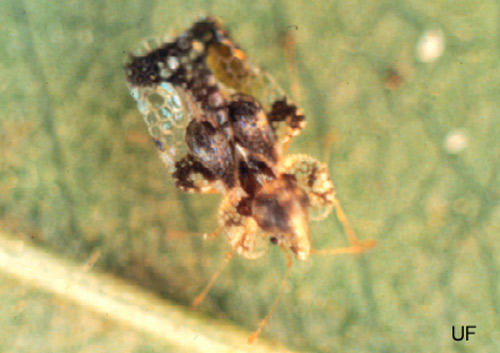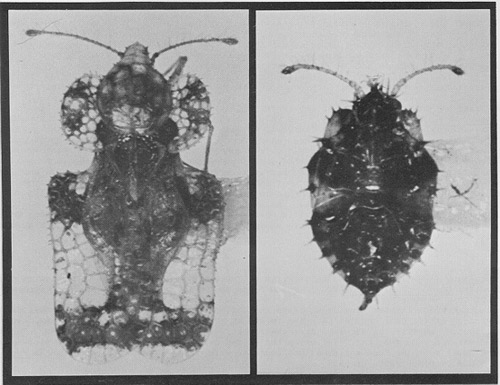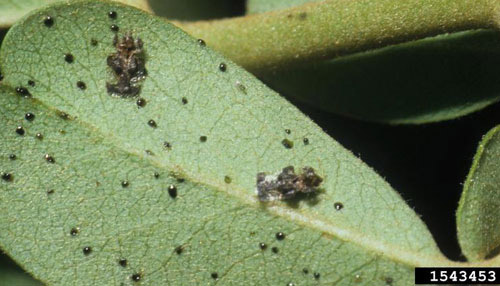common name: hawthorn lace bug
scientific name: Corythucha cydoniae (Fitch) (Insecta: Hemiptera: Tingidae)
Introduction - Synonymy - Distribution - Identification - Life History - Hosts - Detection Notes - Selected References
Introduction (Back to Top)
The hawthorn lace bug, Corythucha cydoniae (Fitch), selectively attacks a variety of woody, rosaceous plants and can cause severe leaf damage. The principal Florida host is firethorn, Pyracantha coccinea Roemer.
Synonymy (Back to Top)
Tingis cydoniae Fitch, 1861
Corythucha arcuata Comstock 1880 (not Say, 1832)
Corythuca arcuata var. crataegi Morrill 1903
Corythucha crataegi Morrill, Osborn & Drake 1916
Corythucha occidentalis Drake (in Gibson 1918).
Distribution (Back to Top)
The hawthorn lace bug, Corythucha cydoniae, occurs throughout much of the continental United States, southern Canada and northern Mexico (Johnson and Lyon 1994).
Most of the Florida records are from the northern part of the state. The oldest Florida specimen in the Florida State Collection of Arthropods (FSCA) was collected at Riverview, Hillsborough County, Florida. With the exception of Hillsborough County, all Florida records are from the northern part of the state.
Identification (Back to Top)
Adults: The adults are delicate, lace-like, with a double crossbar pattern of brown on the hemelytrons (front wings).

Figure 1. Adult hawthorn lace bug, Corythucha cydoniae (Fitch). Photograph by University of Florida.
Eggs: The eggs are smooth, whitish, glistening, semitransparent, ovoid in shape, and 0.3 mm long. The broad end is slightly inserted into the leaf. The upper end of the egg is truncate and has a brown covering. Comstock (1880) reported that the eggs are sometimes confused with certain forms of fungi such as Phoma sp., or with certain kinds of hemipterous galls.
Nymphs: The nymphs are mostly shiny brown, broadly oval, flat and spiny.

Figure 2. Adult (left) and nymph (right) of the hawthorn lace bug, Corythucha cydoniae (Fitch). Photograph by Division of Plant Industry.
There are at least 27 species of Corythucha that feed on deciduous trees and shrubs. Many have specific host preferences, but Corythucha cydoniae does not (Johnson and Lyon 1994). This complicates identification for Corythucha cydoniae.
While Corythucha cydoniae is the only lace bug reported as a pest of Pyracantha (Drake and Ruhoff 1965), adults are needed for confirmation since diagnostic keys do not exist for egg and nymphal stages of Corythucha cydoniae and related species. Other hosts of this lace bug are sometimes attacked by similar species. As a result, host identification alone is not adequate for identifying the hawthorn lace bug, except for Pyrancantha. Field identification of adults is difficult because there are several similar species. Specimens are small and pigmentation is variable within a species. The most valuable diagnostic character is the straight hind margin of the apical, hemelytron crossbar. The following diagnosis (modified from Blatchley 1926) distinguishes Corythucha cydoniae from other species of Corythucha.
The crest of the hood is much elevated, more than twice as high as the median carina (elongated ridge) of the pronotum. The costal area of the hemelytrons typically has basal and apical crossbars, the space between these mostly pale with the front of the hood declivent (sloping downward). Costal margins are nearly straight, but very slightly concave. The outer half of each paranotum (flattened or lamellate sides of pronotum) has a large dark brown spot or stripe, but the stripe often interrupted with pale cells, thus forming two spots on each paranotum; 3.0 to 3.5 mm long, 1.5 to 2.0 mm wide. The external male and female genitalia have diagnostic characters, but require microscopic examination (Bailey 1951, Feldman and Bailey 1953).
Life History (Back to Top)
All lace bugs in the genus Corythucha overwinter as adults, generally in fallen leaves on the ground or other protected spots near their host species (Johnson and Lyon 1994). The eggs are laid in small groups on the lower leaf surface with part of the egg inserted into the leaf tissue. There are five nyphal instars (Johnson and Lyon 1994).
In Florida, nymphs have been reported as early as 7 June and as late as 10 October. Bailey (1951) reviewed existing life history information and added considerable research of his own under New England conditions. He found that the life cycle takes five to seven weeks, depending on the weather, and there was only one full generation per year. However, Johnson and Lyon (1994) report that one or more generations occur depending upon climatic conditions, with one generation per year in New England, and four generations in Maryland.
Sailer (1945) reported that an adult bit his arm six times in approximately 17 minutes, resulting in a reddened square inch of forearm. An itching sensation resulted, but all irritation and evidence of the bites were gone by the next morning. Sailer added that it is common knowledge that Hemiptera will attempt to thrust their mouthparts into any surface upon which they alight, but this type of annoyance is very unusual.
Hosts (Back to Top)
Nearly all host plants are in the family Rosaceae and are listed by Drake and Ruhoff (1965). Firethorn is the most reported host in Florida, but loquat, Eriobotrya japonica Lindl., occasionally suffers injury.
Some of the hosts elsewhere in the U.S. include:
- buttonbush, Cephalanthus occidentalis L.,
- Cotoneaster hupehensis Rehd. & Wils.,
- crabapples, Malus spp.,
- flowering quince, Chaenomeles sp.,
- hawthorns, Crataegus spp.,
- mountain ash, Sorbus spp.
- pear, Pyrus sp.,
- Pyracantha spp.,
- quince, Cydonia sp., and
- shadbush, Amelanchier spp.
Detection Notes (Back to Top)
Infested leaves show a whitish blotching or stipling on the upper surface. Similar stipling is caused by the southern red mite, Oligonychus ilicus (McGregor), which feeds on the upper surface primarily. However, the mite does not stain the lower leaf surface.
Infested lower leaf surfaces have dark brown spots and stains of lace bug excrement and show loss of green color.

Figure 3. Two hawthorn lace bugs, Corythucha cydoniae (Fitch), feeding on the underside of a leaf, with drops of their excrement surrounding them. Photograph by Jim Baker, North Carolina State University, www.forestryimages.org.
On lower surface of leaves look for the lace bug in any of its three life forms: egg, nymph, and adult.
Selected References (Back to Top)
- Bailey NS. 1951. The Tingoidea of New England and their biology. Entomologica Americana 31 (N.S.): 1-140.
- Bailey NS. 1960. Additions to the bioecology of the New England Tingidae and Piesmidae (Heteroptera). Psyche 66: 63-69.
- Blatchley WS. 1926. Heteroptera or True Bugs of Eastern North America, with Especial Reference to Faunas of Indiana and Florida. Nature Publishing Co., Indianapolis. 1116 pp.
- Comstock JH. 1880. The hawthorn tingis (Corythucha arcuata, Say, var.), order Hemiptera; family Tingidae. U.S.D.A. Report of the Entomologist for 1879: 221-222.
- Drake CJ, Ruhoff FA. 1965. Lacebugs of the World (Hemiptera: Tingidae). U.S. Natural History Museum Bulletin 243: 1-634.
- Dress BM, Jackman J. (1999). Lace bug. AgriLife Extension, Texas A&M System. (15 August 2015)
- Feldman AE, Bailey NS. 1953. The taxonomic value of the ovipositor in the New England species of the genus Corythucha Stål (Hemiptera: Tingidae). Psyche 59: 96-104.
- Fitch A. 1861. The quince tingis. Country Gentleman 17: 114.
- Gibson EH. 1918. The genus Corythucha Stål (Tingidae: Heteroptera). Transactions of the American Entomological Society 44: 60-104.
- Morrill AW. 1903. Notes on the immature stages of some tingitids of the genus Corythucha. Psyche 10: 127-134.
- Johnson WT, Lyon HH. 1994. Insects That Feed on Trees and Shrubs. An Illustrated Practical Guide. 2nd ed. rev. Cornell University. Press, Ithaca, NY. 560 p.
- Sailer RI. 1945. The bite of a lacebug, Corythucha cydoniae (Fitch). Journal of the Kansas Entomological Society 18: 1.
- Scott HE. 1960. Lace bugs and their control. North Carolina Agricultural Extension Service Folder 177 (n.p.).